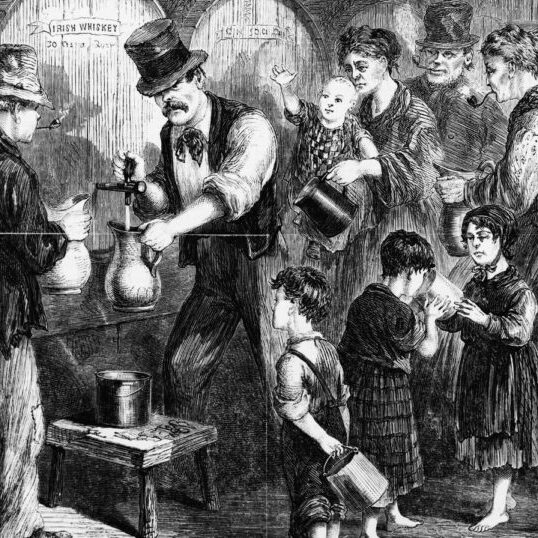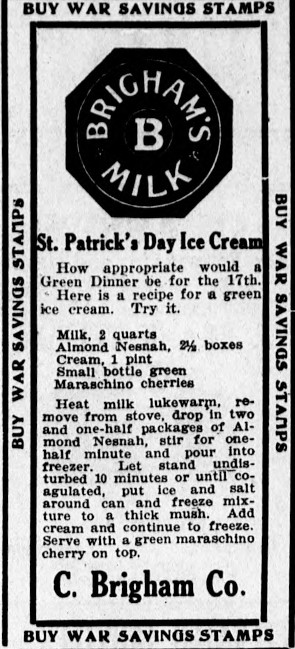
From Papists to Patriots: St. Patrick’s Day in Cambridge
By Beth Folsom, 2022

In the 1840s and 1850s, as a blight on the potato crop left millions of Irish in dire straits, the Cambridge press shared detailed descriptions of their suffering and implored readers to donate to a growing number of relief societies to aid the starving Irish abroad. As the famine reached its peak in the late 1840s, waves of rural Irish arrived in Massachusetts and settled in Boston, Cambridge, and surrounding communities. By 1855, 22% of adults in East Cambridge reported having been born in Ireland, and Irish immigrants made up a sizeable portion of the workforce in the city’s clay pits, brickyards, and glass and furniture factories.[1] Although Cambridge was a welcome respite from their suffering at home, Irish immigrants were not uniformly embraced in their new city; as poor, foreign-tongued newcomers – and especially as Roman Catholics – they were often stereotyped, criticized, and even shunned by white Cantabrigians who considered themselves natives.
During the Civil War era, Irish immigrants and their American-born descendants were depicted in the Cambridge press as lazy, insolent, hot-tempered, and overly fond of drink. At no other time of year were these stereotypes on fuller display than on March 17th: St. Patrick’s Day. The Irish community’s first American celebrations, held in the Boston area to honor the patron saint of their homeland, were described in the Cambridge papers as an excuse for drunkenness, violence, and other unsavory behavior. Despite their contributions to the Union cause during the Civil War, Irish-Americans were still considered suspect, in large part because of unfounded fears by Protestant Americans that their allegiance to the Pope would hold sway over their allegiance to the United States.

An incident in 1870 brings this fear into stark relief: on St. Patrick’s Day of that year, the Cambridge City Council made the decision to fly the American flag over City Hall. Unlike today, when the flag is a regular fixture outside government buildings, Cantabrigians at that time would only observe the flag being raised for specific occasions. Imbued with additional layers of meaning after the bloodshed of the Civil War, the flag was viewed by many as something that should only be brought out for “days of national rejoicing which, by common consent, by universal acclaim, have been thought worthy to be remembered as jubilee days by the State and Nation.”[2] The editors of the Cambridge Chronicle wrote that they experienced “a sense of mortification, of personal shame, of national disgrace” when they saw the flag being displayed on St. Patrick’s Day.[3] In this and future issues of both the Chronicle and the Cambridge Sentinel, mayor Hamlin Harding was roundly criticized for this decision; when Harding ran against Henry Houghton in the 1871 mayoral election, this critique was raised more than once, with Houghton’s supporters assuring the voting public that he would never pander to “Romans” and “Papists” as Harding had done. Around the time of the Revolutionary Centennial in 1876, discussion of making March 17 a holiday in observance of Evacuation Day (when, in 1776, the Continental Army succeeded in driving the British out of Boston) were roundly criticized by those who feared that workers would think they were being given a holiday for “the Irish saint.”
By the late nineteenth century, however, attitudes toward the Irish in Cambridge were beginning to shift. Many of the city’s Irish residents had been born in Cambridge by this time – some were second- or third-generation Cantabrigians. The years between 1865 and 1900 were ones during which the nation contended with the end of slavery and the redefinition of citizenship for Black Americans. In addition, the end of the century saw the demographics of immigration shifting away from Northern and Western Europe; Italians, Russians, and Poles were arriving in larger numbers in the Cambridge area, as were immigrants from China, the Caribbean, and the Middle East. During this period the Irish saw their heritage begin to be embraced by a wider swath of the Cambridge community, with many civic, social, and religious organizations (Protestant as well as Catholic) holding their own St. Patrick’s Day celebrations highlighting the patron saint’s contributions to his adopted homeland. The rise of local Temperance Societies such as that led by Father Theobald Matthew, gave the Irish Catholic community a chance to portray themselves as upright, sober, law-abiding citizens rather than drunken brawlers dependent on government assistance. These societies used the occasion of St. Patrick’s Day to host breakfasts, lectures, and concerts – all very publicly devoid of alcohol in an attempt to counter the previous stereotype of the rum-filled holiday parade.
By the turn of the twentieth century, Irish culture had become part of the mainstream, with a wide variety of social and political organizations holding St. Patrick’s Day celebrations for Cantabrigians of all ethnicities. In early March, the local papers were awash with advertisements for events and goods to mark the holiday, and at the end of the month they reported on the green food, dress, and decorations at various parties and gatherings. As the Irish rose in the ranks of “respectability,” they began to adopt the dominant culture’s attitudes toward other racial and ethnic groups. A 1908 Cambridge Chronicle article notes that “[a] funny situation for St. Patrick’s Day morning, was to see an Irish policeman taking into custody in Central square, an Italian orange peddler.”[4] The Irish were no longer the newly-arrived underclass – Italians and other, newer immigrant groups had taken up that mantle, with Irish Americans now solidly among the ranks to the middle class in much of Cambridge.
Along with asserting their status relative to other immigrants, Irish Cantabrigians also aligned themselves with other whites’ exploitation of Black culture, a trend which was highlighted in early-twentieth-century St. Patrick’s Day concerts featuring minstrel shows with Irish and Irish-American performers in blackface.[5] The descriptions of these racialized events also signaled a shift in tone toward the role of the Irish in American history, no longer portraying them as drunkards prone to poverty and violence, but as upright citizens whose contributions had helped shape the city. In the 1860s, St. Patrick’s Day in Cambridge symbolized the intrusion of an alien religious and ethnic group; by 1920, the Irish were fully integrated into the city’s political, economic and social fabric, and the celebration of this once-foreign holiday had entered the mainstream.
This article was originally published in our “Did You Know?” column in Cambridge Day.
[1] Cambridge Historical Commission website: https://www.cambridgema.gov/historic/cambridgehistory
[2] Cambridge Chronicle, March 19, 1870.
[3] Ibid.
[4] Cambridge Chronicle, March 21, 1908.
[5] For a more thorough discussion of Irish-Black relations, see Noel Ignatiev’s How the Irish Became White. New York: Routledge, 1995.


